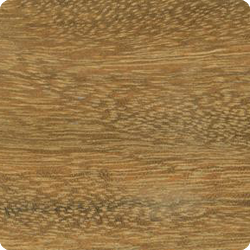Detailed Specs: Greenheart
Scientific Name: Chlorocardium rodiei
Family: Lauraceae
Other Names: Sipiri, Bibiru, Kevatuk, Beeberoe, Demerara Greenheart (Guyana), Groehart, Sipiroe (Suriname)
The Tree
Grows to a height of 130 feet with diameters up to 40 in., commonly 16 to 24 in. In diameter with heights of 100 ft. Boles ar e cylindrical, straight, and clear for 50 to 75 feet with only moderate taper; usually basally swollen or with low buttresses. Also, due to the density of the forest in which the wood grows they develop with very little taper.
The Wood
General Characteristics: Heartwood varies from light to dark olive green or blackish often with intermingling of lighter and darker areas; not sharply defined from the pale yellow or greenish sapwood. Texture fine and uniform; grain straight to roey; lustrous; odourless and tasteless when dry.
Weight: Basic specific gravity (oven dry weight/green volume) 0.80 to 0.91; air- dry density 62 to 70 pcf.
Drying and Shrinkage: The wood dries very slowly with a marked tendency to check and end split; however, warping is not serious and the total amount of degrade is not excessive. Lumber over 1 in. in thickness should be air-seasoned prior to kiln- drying. Kiln schedule T2-C2 is suggested for 4/4 stock and T2-C1 for 8/4. Shrinkage green to oven dry: radial 8.8%; tangential 9.6%; volumetric 17.1%. Movement in service is rated medium.
Mechanical Properties: (First set of data based on the 2-cm standard; second on the 2-in. standard).
|
Moisture |
Bending Strength (psi) |
Modules of Elasticity (1000 psi) |
Maximum Crushing Strength (psi) |
| Green (42)
12% Green (40) 12% |
20,300
26,200 20,900 25,500 |
2310
3040 3040 3700 |
9770 13,040 10,690 13,040 |
Janka hardness 1880 lb for green material and 2360 lb at 12% moisture content.
Working Properties: Moderately difficult to work with hand or machine tools because of its density, dulls cutting edges rather quickly but finishes to a fine smooth lustrous surface. Turns easily and takes a high polish. A moderately good steam -bending wood. Gluing gives variable results.
Durability: The heartwood is rated highly resistant to attack by decay fungi and is also rated as highly resistant to attacks by marine borers but this may vary from one locality to another, particularly in brackish waters. Highly resistant to attack by dry- wood termites.
Distribution: Commercial quantities mostly in the north central portion of Guyana but also found in Suriname and in the Venezuelan Guiana. It has also been reported from the Maroni Region of western French Guiana and from northern Brazil. Preservation: Impermeable to preservative treatments.
Uses: Marine and ship construction, lock gates, docks, industrial floors, vats, filter press plates, piling heavy construction, tur nery, speciality items (fishing rods, billiard cue butts), decking.
References
– Chundnoff, Martin (1984), “Tropical Timbers of the World.” USDA Forest Service Ag. Handbook No.607.



